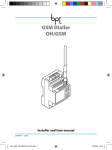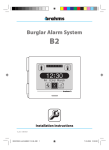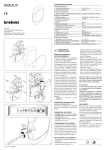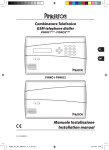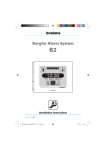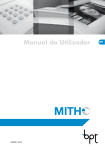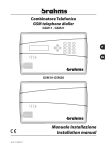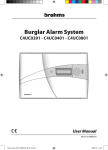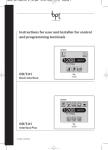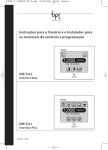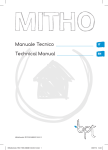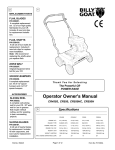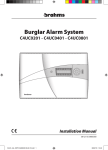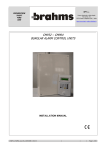Download Module BXGMOH01 for interfacing with Hoasis+Bpt home
Transcript
Module BXGMOH01 for interfacing with Hoasis+Bpt home automation system Installer and User manual 05-02-10/24852701 BXGMOH01 24852701 05-02-10_EN.indd 1 05/02/10 11:59 Use and Applications The BXGM0001 telephone dialler with the addition of the BXGMOH01 card is a device connected to the BPT bus line through a Hoasis+ home automation system, which remotely allows only via SMS to: • Activate scenarios (up to 16) • Query and modify the status and temperature of the thermal zones (up to 20) • Be advised in the event of technical alarms in the home automation system (up to 6) • Be advised in case of damage (outage) and reset of home electrical power • Carry out a system check every 12/24 hours The device must be programmed through the programming software. The device is also equipped with a normally open relay contact which can be used to activate TH Bpt heat regulators designed for remote control or any other device set up for this purpose, controlled through the opening or closing of a contact. m Important! • The updated version of the programming software can be downloaded from the website: www.bpt.it section “Download ” > “Software”. The download password is OHSW2K7GSM 2 BXGMOH01 24852701 05-02-10_EN.indd 2 05/02/10 11:59 Index Use and Applications . . . . . . . . . . . . . . . . . Page 2 Safety warnings . . . . . . . . . . . . . . . . . . . . . . . Page 4 Installer instructions User instructions Installation of the SIM card and the card BXGMOH01 . . . . . . . . . . . . . Page 6 Commands performed by the User via SMS . . . . . . . . . . . . . . . . . . . Page 20 Insert a scenario . . . . . . . . . . . . . . . . . . . . . . . . . . . . . 20 Customization of commands that can be performed by SMS. . . . . . . . . . . . . . . . . . . . 20 Request information on the system status . . . . 20 SMS messages from BXGM0001 dialler + BXGMOH01 card. . . . . . . . . . . . . . . . . . . . . 22 Find out your remaining SIM credit . . . . . . . . . . . 22 Terminal boards and connectors . . . . . Page 7 Commissioning . . . . . . . . . . . . . . . . . . . . . . . Page 8 Connection diagrams . . . . . . . . . . . . . . . . . Page 9 Programming of the dialler through programming software . . . . . Page 11 Activate/Deactivate information on the system status . . . . . . . . . . . . . 12 Create an address book . . . . . . . . . . . . . . . . . . . . . . 12 Special telephone numbers in the address book . . 12 Thermal zones . . . . . . . . . . . . . . . . . . . . . . . . . . . . . . . 13 Technical alarms . . . . . . . . . . . . . . . . . . . . . . . . . . . . . 13 Scenarios . . . . . . . . . . . . . . . . . . . . . . . . . . . . . . . . . . . . 14 Reminder of the Dialler settings . . . . . Page 23 Programming of the dialler through SMS . . . . . . . . . . . . . . . . . . . . . . . . . . Page 15 Create an address book . . . . . . . . . . . . . . . . . . . . . . 15 Add a telephone number to the address book. . 16 Modify a telephone number in the address book 16 Deletion of a telephone number in the address book . . . . . . . . . . . . . . . . . 16 Special telephone numbers in the address book . 16 Find out your remaining SIM credit . . . . . . . . . . . 16 Deactivate SMS reception by a number in the address book . . . . . . . . . . . . . . . . . . . . . . . . . . 17 Activate/Deactivate information on the system status . . . . . . . . . . . . . . . . . . . . . . . . . 17 3 BXGMOH01 24852701 05-02-10_EN.indd 3 05/02/10 11:59 Safety Warnings m ATTENTION • After removing the packaging, check the condition of the unit. • The packaging items (plastic bags, expanded polystyrene, etc.) must not be handled by children as they may be dangerous. • Carefully read the instructions before starting installation. Perform work as specified by the manufacturer. • Before connecting the equipment, make sure that the rating plate data corresponds to that of the distribution network. • An omnipolar switch, with contacts separated by at least 3mm, must be installed upstream on the equipment, on the electric system of the building. • The manufacturer declines all liability for any damage as a result of improper, incorrect or unreasonable use. • Before performing any cleaning or maintenance operation, disconnect the equipment from the power supply network by opening the system switch. • In case of failure and/or malfunction of the device, detach it from the power supply and do not tamper with it. • Use original spare parts. • Installation, programming, commissioning and maintenance of the product must only be performed by qualified technicians who have been properly trained in compliance with current standards including compliance with accident prevention. • Operate in sufficiently lighted areas that are conducive to health and use tools, utensils and equipment that are in good working order. • Upon completion of installation, always check for correct operation of the unit and the system as a whole. • Do not install the device outdoors or in areas where it is exposed to seepage or splashes of water. • Handle the device with care. It contains electronic parts that are fragile and sensitive to humidity. • The electronic cards can be seriously damaged by discharges of static electricity. If they are to be handled, wear suitable clothing and anti-static footwear, or at least, ensure static electricity has been discharged by touching with the fingertip a metallic surface connected to the earth system (e.g. the chassis of a household appliance). • Weld the joints between wires to prevent false alarms caused by oxidation of the wires. • The electrical system must comply with current standards in the country of installation. • Failure to comply with the above instructions may compromise the unit’s safety. • The installer must make sure that the information for the user, where applicable, is present on the devices. • Dispose of the unit in accordance with current standards. 4 BXGMOH01 24852701 05-02-10_EN.indd 4 05/02/10 11:59 Installer instructions BXGMOH01 24852701 05-02-10_EN.indd 5 05/02/10 11:59 Installation of the SIM card and the card BXGMOH01 In order to operate, the device must be equipped with a SIM card, not included in the package, to be inserted in the appropriate housing. The device can work in conjunction with Hoasis Bpt systems by adding the interface model BXGMOH01 to be installed as shown in the figure. To do this, unscrew the two fastening screws and remove the dialler cover. Do this making sure that you do pull out the antenna wire. SIM card not included SIM card housing Optional module BXGMOH01 for interfacing with Hoasis+ BPT home automation system m ATTENTION • If the SIM card is new, prior to inserting it into the communicator, make a call by inserting it into a mobile phone thus allowing the mobile telephone operator to register the card. • The device requires that the SIM cards are activated only vocally and by SMS (No SIM Data!) • Before carrying out the programming operation, deactivate the SIM card PIN code. c ATTENTION! The electronic cards can be seriously damaged by discharges of static electricity. If they are to be handled, wear suitable clothing and anti-static footwear, or at least, ensure static electricity has been discharged by touching with the fingertip a metallic surface connected to the earth system (e.g. the chassis of a household appliance). 6 BXGMOH01 24852701 05-02-10_EN.indd 6 05/02/10 11:59 Terminal boards and connections RS 232 connector to interface the module with a PC Optional auxiliary battery connector Green LED: Voltage present CN1 M2 Yellow LED GSM transmission/reception in progress CN4 DL1 3 2 Red LED On HOASIS systems the LED is always on With Bus B2 connected it indicates transmission/ reception of data in progress Connection for antenna SIM Card SIM Card housing Jumper SW1 TAMPER disabled CN5 B2 C NO TAMPER TMP LCK DFT BTL LA M1 BUS LA Terminals BUS - LA BUS - B2 M1 C, NO TAMP BUS B2 C N0 TAMP Jumper SW4 boot loader Jumper SW3 default reset Meaning Terminal board for Bpt BUS Hoasis connection Terminal for connection to BUS B2 BRAHMS Relay contact 12V 1A (normally open) Terminal board for TAMPER contact connection Terminal board for earth connection M2 SW1 SW2 SW3 SW4 SW1 SW2 SW3 SW4 Jumper SW2 address book protection TMP LCK DFT BTL Terminal board for connection to power supply from power supplier When the jumper is connected the tamper contact is disconnected When the jumper is disconnected the address book cannot be modified via SMS By powering the module without jumper the default configuration is reset Boot-loader (jumper reserved for the Technical Service not to be removed) 7 BXGMOH01 24852701 05-02-10_EN.indd 7 05/02/10 11:59 Commissioning m ATTENTION Before installing the module it is important to verify that there is an adequate radio receiving signal from the device in the area where the device needs to be installed. To do this, simply insert the SIM in a mobile phone and check reception. If reception is poor the device will have to be installed in another location with a better signal. Please be informed that the company Brahms S.r.l. declines all liability in the event of: • failed transmission, failed reception, delayed transmission or delayed reception of SMS messages by the dialler, when these are due to the quality of the reception signal or to any other problem related to the mobile telephone operator’s activities. • charging cost on the dialler remaining SIM credit resulting from messages sent by the mobile telephone operator or from other services carried out by the mobile telephone operator. Once the module has been placed in the appropriate containers, as described in the previous pages, proceed as follows: • Ensure voltage has been removed to the system. • Connect the dialler to the BPT HOASIS home automation system through the BUS LA terminal . • Now restore voltage to the system. • The lighting of the green LED indicates that the module is powered. • The yellow LED, will remain on for a few seconds, during which the GSM device will verify mobile reception. If after a few seconds the yellow LED switches off the operation was successful. If, on the contrary, the yellow LED remains on this may indicate that there are GSM communication problems, related to reception failure or SIM registration (see chapter “Assembly of SIM Card”). Once the installation has been completed the yellow LED will flash only in case of data transmission/reception on the GSM network. m ATTENTION Connect the BPT home automation BUS to the terminals LA, not to the terminals B2. 8 BXGMOH01 24852701 05-02-10_EN.indd 8 05/02/10 11:59 Connection of BXGM0001+ card BXGMOH01 in mixed system comprised of Hoasis+ BPT home automation - Brahms B2 burglar alarm OH/A.01 OH/RI M3 LA LA LA OH/MA BXGM0001 +BXGMOH01 BUS LA LA M1 BUS B2 OH/T.01 M2 B2AL0001 B2SEAL01 M2 24 V BUS 30 V BUS M1 B2IPPA01 + – + BAT – 12 V TAMPER BUS BB065 B2UC0001-B2UC0002 – + BUS BB065 – + 230Vac Fig. 5 9 BXGMOH01 24852701 05-02-10_EN.indd 9 05/02/10 11:59 Connection of BXGM0001+ card BXGMOH01 in combined system with Hoasis BPT + additional power supplier OH/AS and Brahms B2 OH/AS M2 LA OUT LA IN M3 – BATT 1 + – BATT 2 + OH/RI LA BB065 – + OH/MA BB065 – + OH/A.01 LA M3 LA OH/T.01 LA BXGM0001 +BXGMOH01 BUS LA M1 BUS B2 M2 B2AL0001 B2SEAL01 M2 24 V BUS 30 V BUS 12 V M1 B2IPPA01 + – + BAT – TAMPER BUS OH/B065 + – B2UC0001-B2UC0002 OH/B065 + – BUS 230Vac Fig.6 10 BXGMOH01 24852701 05-02-10_EN.indd 10 05/02/10 11:59 Programming of the dialler through programming software In order to programme the module create the system structure through the programming software, acquire the GSM module identification code and proceed as follows. Display the system structure by pressing the “Plant structure” menu. Fig. 7 In order to add the GSM dialler to the system, press “Connections-Network”. Select the “GSM module” icon from the window containing the module list and drag it to the desired switchboard (fig. 7). At this point, the identification code, previously acquired, must be assigned to the module; to do this, select the module icon, press “Modify” and associate ID to the module from the appropriate menu (fig. 8). Fig.8 11 BXGMOH01 24852701 05-02-10_EN.indd 11 05/02/10 11:59 ACTIVATE/DEACTIVATE INFORMATION ON SYSTEM STATUS (Check 12/24) In order to receive information on the system status every 12 or 24 hours on your mobile phone proceed as follows. Click on the drop-down menu “Check 12/24” (fig. 9) and choose to activate the system check every 12, 24 hours or select “Off” to deactivate this option; then choose the day on which the check is to be performed and the time in which the message is to be received. Fig.9 By selecting 12 or 24, the GSM module will send a descriptive SMS on the system status to the first number in the address book every 12 or 24 hours , for example: HOASIS: Network status ON, alarms OK, zone AUTO, temp. 20.0C . Note: The information on the heat regulation, refers to the first one in the list of the dialler thermal zones. Fig.10 CREATE AN ADDRESS BOOK (Telephone number 01 - 10) The following boxes are designed to contain the numbers (maximum 10) of the users that will use the GSM module services. By simply clicking in the appropriate boxes it will be possible to enter the telephone numbers that will make up the address book (fig. 10). m ATTENTION • Always enter the appropriate international dialling code before the numbers that are being added to the address book (+39 for Italy). • The telephone numbers can contain up to 19 digits. In case of numbers containing more than19 digits and up to 24, it will be possible to programme the telephone numbers in the address book via SMS, as described in the following chapters. SPECIAL TELEPHONE NUMBERS IN THE ADDRESS BOOK (Telephone number 11) It is possible to allow the messages from a specific telephone number to be sent to the first number in the address book. To do this, enter the number from which the messages are sent in box 11 of the address book. This function can be used to allow the informational messages from the specific mobile telephone operator (for example information on the low credit status) to be sent to the first number in the address book; to do this it is necessary to know the number for “Centro Servizi” of the specific mobile telephone operator. This number can be obtained by contacting Customer Service. 12 BXGMOH01 24852701 05-02-10_EN.indd 12 05/02/10 11:59 For example: Telecom Italia Mobile Vodafone Italia +393359609600 +393359608000 +393492000200 THERMAL ZONES (Thermal zone 01 - 20) Through the dialler it is possible to manage up to 20 thermal zones; to do this associate the thermal zones created through programming software to the specific boxes conFig.11 tained in the programming window of the GSM Module. By simply clicking in the appropriate boxes it will be possible to choose one of the available Thermal Zones from a drop-down menu (Fig. 11). TECHNICAL ALARMS (Technical alarm 01 - 06) The GSM module can send a warning SMS in the event of an “Technical alarm”; this alarm must be programmed first through programming software, as follows: Fig.12 13 BXGMOH01 24852701 05-02-10_EN.indd 13 05/02/10 11:59 Display the system structure by pressing the menu “Plant structure”; select the entry “Security” on the left hand side of the screen and click on the icon “Alarms”; choose the icon of the alarm that needs to be inserted, from the list of alarms displayed on the right hand side of the screen, drag it inside the desired “Space” (fig. 12) and associate the created alarm to one of the inputs of the system. Press “Plant structure” to return to the window displayFig.13 ing the system structure, select the icon for the GSM module and access the module programming window again by pressing “Modify”. By clicking on one of the 6 boxes reserved for the alarms the programmed alarms will now be displayed in the list and it will be possible to associate them to the available 6 alarm boxes (fig. 13). SCENARIOS (Scenario 01 - 16) It is possible to activate, through the dialler, up to 16 scenarios; to do this, associate the scenarios created through programming software to the appropriate boxes contained in the GSM Module programming window. By clicking on one of the 16 “Scene” boxes on the programming window choose one of the available scenarios from the drop-down menu (fig. 14). . Note: Fig.14 • It is highly recommended (in order to make the use of the module easier for the User) to follow the sequence of “Thermal zone” and “Scene” that have been inserted on OH/T terminal. • Brahms declines all liability in case of transmission of SMS by the mobile telephone operator that decrease the dialler remaining SIM credit . • On page 23, the User can take note of the main programmed parameters for his own benefit and as a written reminder in case of future work on the system. 14 BXGMOH01 24852701 05-02-10_EN.indd 14 05/02/10 11:59 Programming of the dialler via SMS The BXGM0001 dialler with the additional BXGMOH01 card allows remote control and signalling functions via the receipt and sending of SMS messages from and to the telephone numbers contained in the address book saved on the internal memory of the dialler itself. .Note: All the following settings can be programmed simply and intuitively through the use of programming software by connecting the system to a PC through the OH/SW interface without SMS. m Important! • Before starting programming the address book via SMS make sure that the jumper SW2 (LCK) is connected . With a disconnected jumper the programming of the address book can only be performed through programming software. • It is important to enter the appropriate international dialling code before the numbers that are being saved in the address book (+39 for Italy) . • The dialler, when purchased, can receive programming messages sent by any telephone number. It is therefore advisable, once the programming of the address book has been completed, to disconnect the jumper SW2. CREATE AN ADDRESS BOOK The address book can be easily created via SMS messages structured in such a way that they carry the information necessary for programming the module. The address book can contain up to10 telephone numbers. Every programming SMS can send up to 5 numbers to the address book. These SMS messages must have the following structure: SMS no.1 P R O G N U M T E L 1 . first telephone number . second telephone number . third telephone number . fourth telephone number . fifth telephone number . SMS no. 2 P R O G N U M T E L 2 . sixth telephone number . seventh telephone number . eighth telephone number . ninth telephone number . tenth telephone number . Example If the GSM dialler must send or receive messages to/from only two numbers, the address book programming message will have the following structure: P R OG N UM T E L 1 . + 3 9 3 4 7 1 2 3 4 5 6 7 . + 3 9 3 3 3 3 4 5 6 7 8 9 . m Important! The address book that is created via SMS will totally overwrite any pre-existing address book. 15 BXGMOH01 24852701 05-02-10_EN.indd 15 05/02/10 11:59 ADD A TELEPHONE NUMBER TO THE ADDRESS BOOK If a telephone number needs to be added to the address book proceed as follows: Example If the address book contains 5 numbers, in order to add a sixth number, send the following message to the dialler: MO D N UM T E L ( 6 ) + 3 9 3 3 3 8 8 8 8 8 8 8 . This message overwrites a number in position 6 in the address book. MODIFY A TELEPHONE NUMBER IN THE ADDRESS BOOK If a telephone number in the address book needs to be modified proceed as follows: Example The message shown in the example allows to overwrite the number in position 2 of the address book with a new one that will have to be written after the text “MODNUMTEL(2)”. MO D N UM T E L ( 2 ) + 3 9 3 3 3 5 5 5 5 5 5 5 . DELETION OF A TELEPHONE NUMBER IN THE ADDRESS BOOK If a telephone number in the address book needs to be deleted proceed as follows: Example The message shown in the example allows to delete the number in position 5 of the address book leaving the same position in the address book empty; the message has the following syntax: MO D N UM T E L ( 5 ) _ . SPECIAL TELEPHONE NUMBERS IN THE ADDRESS BOOK It is possible to allow the messages from a specific telephone number to be sent to the first number in the address book. This function can be used to allow the informational messages from the specific mobile telephone operator (for example information on the credit) to be sent to the first number in the address book; to do this it is necessary to know the number for “Centro Servizi” of the specific mobile telephone operator. This number can be obtained by contacting Customer Service. The programming message will have the following syntax: P R O G N U M G E S . number for telephone operator service centre . In order to deactivate the function enter P R OG N UMG E S . 0 . FIND OUT YOUR REMAINING SIM CREDIT In order to find out the remaining credit of your SIM it is necessary to send an SMS specifically structured depending on your telephone operator preceded by the word “CREDIT”. Some operators, for example Telecom Italia Mobile, require a message consisting of text + number; in this case the message will have the following syntax: C R E D I T “ P R E CRE S I N“4916 . 16 BXGMOH01 24852701 05-02-10_EN.indd 16 05/02/10 11:59 Other Operators, Vodafone Italia for example, require a simple number to be sent. The message will have the following syntax: C R E D I T 1 “ C A L L “+4 04 . DEACTIVATE SMS RECEPTION BY A NUMBER IN THE ADDRESS BOOK The default settings allow an event to be reported to all users through an SMS. However it is possible to prevent some numbers from receiving these messages. Example If you wish to prevent the fifth number in the address book from receiving SMS the programming message will have the following syntax: P R O G S M S ( 5 ) OFF . In order to reactivate SMS reception by the number the programming message will have the following syntax: P R O G S M S ( 5 ) ON . . Note: It is possible to deactivate SMS reception by a certain number only through programming via SMS. ACTIVATE/DEACTIVATE INFORMATION ON THE SYSTEM STATUS It is possible to receive information on the system status on your mobile phone every 12 or 24 hours. Example If you wish to receive information on the system status every 12 hours the programming message will have the following syntax: C H E C K ( 1 2 ) ON . If you wish to receive information on the system status every 24 hours the programming message will have the following syntax: C H E C K ( 2 4 ) ON . In order to deactivate this function the programming message will have the following syntax: CHE CK ( 1 2 ) OFF . or CHE CK ( 2 4 ) OFF . . Note: • Brahms declines all liability in case of transmission of SMS by the mobile telephone operator that decrease the dialler remaining SIM credit . • On page 23, the User can take note of the main programmed parameters for his own benefit and as a written reminder in case of future work on the system. 17 BXGMOH01 24852701 05-02-10_EN.indd 17 05/02/10 11:59 18 BXGMOH01 24852701 05-02-10_EN.indd 18 05/02/10 11:59 User instructions BXGMOH01 24852701 05-02-10_EN.indd 19 05/02/10 11:59 Commands performed by the User via SMS The Users whose numbers have been inserted in the address book can, through SMS messages, remotely control their Hoasis home automation system or request information on the status of the system. INSERT A SCENARIO If (for example), during programming, through programming software, a scenario identified as “NIGHT”has been created, in order to activate that scenario an SMS with the following syntax will have to be sent to the dialler: S C ENAR I O “ N I GHT “ Once the command has been performed, the dialler will send a confirmation message to the user that has activated the scenario: HOASIS:“NIGHT” on CUSTOMISATION OF COMMANDS PERFORMED VIA SMS The SMS messages that are sent to the GSM module can be customised, allowing them to be memorised and subsequently transmitted more easily, or written in a different language from the default one (Italian). The customisation can be carried out using the SMS messages described in the column highlighted in the table (customised SMS sent by the User), where in place of the word “Commento”, a customised text can be added. For instance, in order to activate the scenario “NIGHT” previously created through programming software the following SMS can be used: 1 <I WAN T T O A C T I VA T E T H E S C E NA R I O> “ NO T T E “ that will receive the confirmation HOASIS:“NIGHT” on Or in order to find out the status of the system the following SMS can be sent: 4 <WHA T I S THE S T A TUS OF T H E S Y S T EM? > that will receive the reply HOASIS: Network status ON, alarms OK, zone AUTO, temp. 22.6C REQUEST INFORMATION ON THE STATUS OF THE SYSTEM In order to find out the general status of the system, send an SMS with the following syntax: S TATO I M P I ANTO Or in order to find out the status of the system the following SMS can be sent: 4 <WHA T I S THE S T A TUS OF T H E S Y S T EM? > A reply message will be received describing the status of the system, for example: HOASIS: Network status ON, alarms OK, zone MAN, temp. 20.5C Or it is possible to request information on the status of a specific “climate room” previously created through programming software. 20 BXGMOH01 24852701 05-02-10_EN.indd 20 05/02/10 11:59 In the following example information is requested on a zone identified as “living room” S T A T O C L I M A “ L I V I N G R OOM “ A reply message will be received describing the status of the specific zone, for example: Clima “living room” AUTO 20.8C The following table shows a list of all possible messages that can be sent to the dialler in order to perform operations remotely or to receive information on the status of the system. SMS sent by the User customised SMS sent by the User Scenario “scenario name” Clima “zona name” AUTO 1 <Comment> “scenario name” 2 <Comment> “zona name” AUTO Function Scenario activation Setting of thermal zone in AUTO mode Setting of thermal zone in Manual mode for example at 20°C temperature Setting of thermal zone in OFF mode HOASIS: “scenario name” on Climate “zona name” AUTO 23,5C Clima “zona name” 2 <Comment> MAN.20. “zona name” MAN.20. Clima “zona name” OFF Stato clima “zona name” 2 <Comment> “zona name” OFF 3 <Comment> “zona name” System status request Stato impianto 4 <Comment> Request for activation/deactivation of SMS on system status (every 12 or 24 hours) Check (12/24) ON/OFF 5 <Comment> (12/24) ON/OFF Thermal zone status request Reply SMS to the User Climate “zona name” MANUAL 20.0C Climate “zona name” OFF 23,2C Climate “zona name” AUTO/MANUAL/OFF 20,8C HOASIS: Network status ON, alarms OK, zona MAN, temp. 20,5C Check (12/24) ON/OFF In SMS containing “nome zona” or “nome scenario”, write the name of the thermal zone or scenario, in exactly the same way as indicated in the programming software. . Note: In the event of a text message requesting the system status or heating zone status, the controller will give a system or zone temperature between 10.0°C and 35.0°C even when the system or zone temperature is lower or higher than this interval. For example, if the temperature in the heating zone is 8.5°C, the controller will respond with a zone temperature of 10.0°C. The device is equipped with a relay contact that can be used to activate any controllable device by opening or closing a contact. Specifically, with the message “RELAY TH” you can control impulse contact devices, such as the heat regulators of the series TH Bpt set up for remote control (TH/125 - TH/350 - TH/450). Function Closing of the dialler auxiliary contact relay SMS sent by the User R E L E R E L E Opening of the dialler auxiliary contact relay Closing of the dialler auxiliary contact relay for 3 seconds R E L E for activation of Bpt programmable thermostats Relay status request R E LAY Reply SMS to the User ON RELAY ON OF F RELAY OFF TH S TATUS RELAY TH ON RELAY ON RELAY OFF 21 BXGMOH01 24852701 05-02-10_EN.indd 21 05/02/10 11:59 . Note: The “RELE TH” command, sent to Bpt programmable thermostats, activates a specific programme. For more details refer to the programmable thermostats manuals. SMS MESSAGES FROM BXGM0001 DIALLER + BXGMOH01 CARD The dialler sends informational messages on the control unit status to the numbers contained in the address book. For instance, in the event of a technical alarm, the dialler sends a message indicating the type of technical alarm occurred followed by the date and time of the event. Messages on technical alarms and network outage and reset, will be sent to all numbers contained in the address book (max 10). Informational SMS messages on “stato centrale” sent by the dialler to the User Event SMS Message received Technical Alarm Technical alarm “nome allarme” <25-05-07><18:35> Electrical power outage Electrical power reset Power outage <28-05-07><19:35> Network reset <28-05-07><20:35> HOASIS: Network status ON, alarms OK, zone AUTO, temp. 20.0C System status (every 12/24 hours) Furthermore, the dialler, if correctly programmed, will also send all messages from the telephone operator service centre to the first valid number in the address book, indicating the credit deadline. FIND OUT YOUR REMAINING SIM CREDIT In order to find out the remaining credit of your SIM it is necessary to send an SMS specifically structured depending on your telephone operator preceded by the word “CREDIT”. Some operators, for example Telecom Italia Mobile, require a message consisting of text + number; the message will have the following syntax: CR ED I T “ P R E CR E S I N “ 4 9 1 6 . Other Operators, Vodafone Italia for example, require a simple number to be sent. The message will have the following syntax: CR ED I T 1 “ CA L L “ + 4 0 4 . .Note: • Through SMS messages it is possible to perform only one command for each message (activate only one scenario, change the status of the thermal zone). • The confirmation message, depending on the telephone operator, could take a few minutes. • BPT declines all liability in case of transmission of SMS by the mobile telephone operator that decrease the dialler remaining SIM credit . • If a message is sent by a number not present in the address book in order to activate one of the services the following reply will be received: Telephone number not found in Phonebook. 22 BXGMOH01 24852701 05-02-10_EN.indd 22 05/02/10 11:59 • The messages sent and received by the GSM will be automatically deleted to prevent the SIM card memory from running out . Reminder of the Dialler settings Reminder of the numbers saved in the address book and their location Position Number User name 01 02 03 04 05 06 07 08 09 10 11 Mobile Telephone Operator “Centro Servizi” No. 01 02 03 04 05 06 07 08 09 Reminder “Zone Termiche” Zone name 10 11 12 13 14 15 16 17 18 19 20 No. 01 02 03 04 05 06 07 08 09 Reminder “Scenari” Scenario Name 10 11 12 13 14 15 16 23 BXGMOH01 24852701 05-02-10_EN.indd 23 05/02/10 11:59 BPT Spa Centro direzionale e Sede legale Via Cornia, 1/b 33079 Sesto al Reghena (PN) - Italia http://www.bpt.it - mailto: [email protected] BXGMOH01 24852701 05-02-10_EN.indd 24 05/02/10 11:59
























